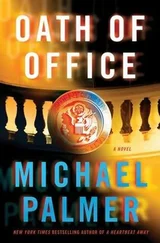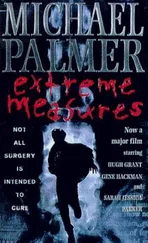O’Neil turned without a reply and rushed ahead to catch up with the president. Ellis watched until the group had disappeared through a guarded exit.
Third.
The word echoed in her mind. She was third in line to govern the most powerful nation on earth. And all of a sudden, the two above her seemed to be on very shaky ground.
DAY 1
10:00 P.M. (EST)
Allaire led his team past the Secret Service agents guarding the mahogany double doors located directly to the right of the rostrum. The corridor, accessible only to members of Congress and their staff, had reinforced walls that dampened the din from within the House Chamber.
Near the end of the passageway, the president used a keycard to unlock another wooden door. Sensors detected movement inside the pitch-black room, and turned on several banks of overhead fluorescent lights.
Allaire proceeded to a keypad on the right-hand wall. Punching in his code, he waited for the hydraulics to engage. In seconds, the wall opposite him slid noiselessly downward and disappeared, revealing the Hard Room. The array of communication equipment—satellite phones, wall-mounted monitors, radios, printers, radar imaging systems, and laptop computers—gave him a brief flare of confidence that his government possessed the power to prevail against any adversary. Then he reminded himself that this was no ordinary adversary—this was WRX3883 in the hands of depraved killers, and at this moment, nothing existed inside this room, or any other, that could defeat that combination.
The large conference table in the center of the room would serve as their briefing area. Two Cabinet secretaries—Salitas and Broussard—took their seats, along with Allaire’s physician Bethany Townsend, the vice president; uniformed Admiral Archie Jakes (the chairman of the Joint Chiefs of Staff); the head of the Capitol Police force, Hank Tomlinson; Architect of the Capitol Jordan Lamar and White House Chief of Staff Megan McAndrews. O’Neil, square-jawed and swarthy, remained standing against the back wall.
“Where is Paul Rappaport?” Allaire asked.
“Paul is at home in Minnesota, Mr. President,” McAndrews said, “tending to his daughter.”
Minnesota. Allaire groaned. He had personally approved the trip.
“Yes, of course,” he said. “Sorry.”
For this year’s State of the Union Address, Paul Rappaport was the so-called designated survivor.
No State of the Union Address, inauguration, or other momentous occasion occurred without there being a DS—referred to by some as the Doomsday Successor. The DS was the only one of the fifteen Cabinet members officially in line to succeed the president who was deliberately not in the vicinity of Washington, D.C. He or she was chosen for the job by the military through the President Emergency Operations Center, or PEOC—the same unit with operational control of the Hard Room.
Given that every member of the Cabinet wanted to be near the POTUS during major events, the chosen DS, usually at or near the bottom of the chain, had no desire to be the one selected. Paul Rappaport’s appointment, however, was a logical one—one that the former governor had actually requested.
Not only was the Homeland Security secretary a logical choice, being the most recently established Cabinet position, but just a week earlier, Rappaport’s daughter’s condo had been broken into and ransacked while she was in the shower. Stolen were her purse, wallet, laptop computer, iPad, cell phone, silverware, and jewelry. Even worse, the president had been informed, her underwear had been removed from her bureau drawer, cut up, and spread out on her bed. The daughter, Renee, had a history of profound anxiety and depression, and suffered a breakdown as a result of the invasion. She had just been discharged after several days in a psychiatric hospital, and was at her parents’ place.
Allaire imagined that the flamboyant, furiously patriotic Rappaport, protected by a small detachment of Secret Service agents, was with his wife and only child at the moment, watching what had been the president’s address, and still unaware of how close he suddenly was to history.
“Sir, I respectfully suggest we get on with this briefing,” said Gary Salitas, Allaire’s closest friend in Washington.
Allaire perked up. He had been quiet too long, lost in thought as the weight of evolving events descended upon him.
“Yes, of course, Gary. Thank you. Sean, can you give me an update on the mobile device roundup?”
The Secret Service agent stepped away from his position against the Hard Room wall.
“Agents are collecting them as you ordered, Mr. President. It’s a difficult assignment, though, as you can well imagine. Many of those out there aren’t used to being told what to do. I doubt the press people are being forthcoming in handing over all the phones they have. We may have to resort to searching them.”
Allaire sighed. The most probable scenario, and an alarming one at that, had word already spreading to the outside world via text messages, phone calls, broadcasts from network and cable television operators’ mobile units from outside the Capitol, and transmissions via the Internet—all reporting something epic happening at the State of the Union, but nobody knowing exactly what. Speculation would spread quickly to every country in the world, from major cities to any remote village with even the slightest bit of communication technology.
Crisis at the Capitol.
It was likely that CNN’s producers had already ordered the graphics.
The best Allaire could hope for would be to slow the spread of information and misinformation until he could work out a strategy as to how it should be presented and disseminated, and how to prevent the reaction that would ensue from any perceived lack of leadership.
He looked over at Salitas for suggestions.
“We need to think bigger, Mr. President,” Salitas, a graying MIT grad, said. “We should disrupt all communications—cellular, landline, Internet, TV broadcast, for say, a five-mile radius around the Capitol.”
“Can we do that?”
“We can try.”
“And still allow me to broadcast to the people?”
“With any luck.”
“Do it.”
Salitas crossed to the communications center at the far side of the room and began making calls.
“Okay, it’s time,” Allaire said. “I’m going to brief you all. Soon I’ll share this information with the other victims out there.”
“Victims?” HHS secretary Kate Broussard asked.
“Yes, Kate. Victims. That’s what we are now. All of us.” He described the message on the teleprompter. “Assuming the exploding glass containers in those bags and briefcases contained aerosolized WRX3883, we must consider that every single person inside the Capitol tonight has been exposed or will soon be exposed to one degree or another.”
“What on earth is WRX3883?” Broussard said.
“It’s a biological agent we’ve been tracking for some time now.”
From his position across the room, Salitas’s eyes narrowed. He gave what Allaire took to be a look of warning.
“Whose biological agent? Are we talking Al Qaeda?” Admiral Jakes managed to ask between sudden spasms of coughing.
“No. Genesis has taken credit for this one. It’s a virus we know about, though. Apparently they stole it.”
“Why weren’t we made aware of this before? What does it do?”
“I’m sorry, Archie. I chose to keep all information about the virus in house until we knew more of what we had. The microbe was ours. It was initially developed at Columbia University in New York. We took it over and were working on it at a Level Four containment facility in Kansas. About nine months ago, I pulled the plug on the project. Apparently, Genesis found a way to steal some.”
Читать дальше












